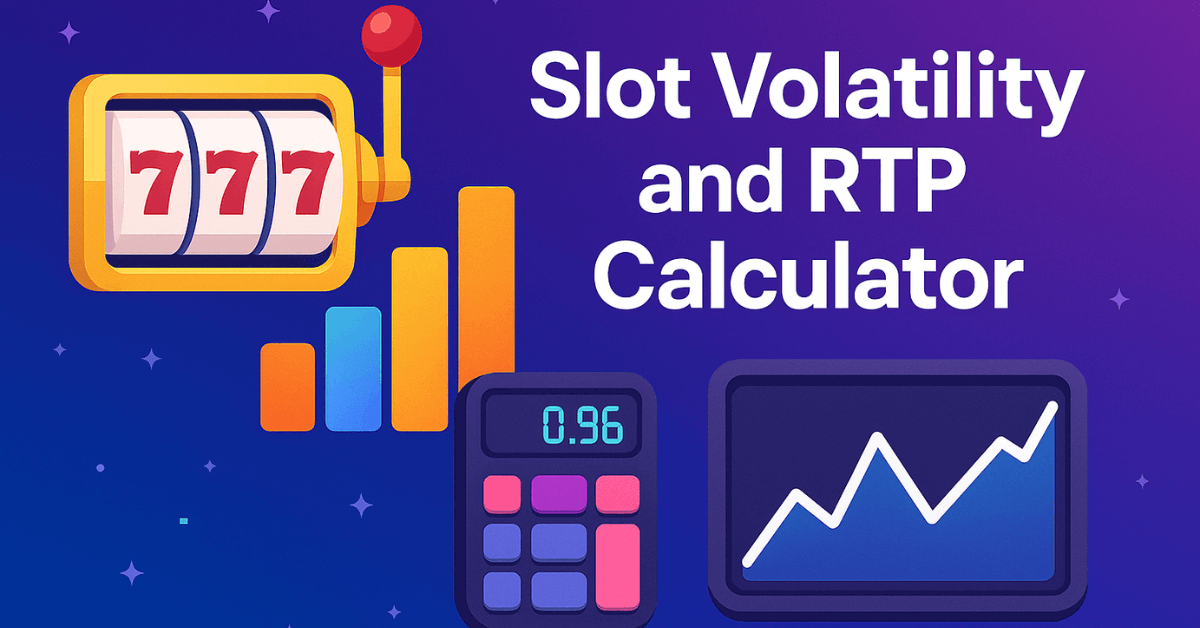
🎰 Slot Volatility and RTP Calculator – Understand Slot Risk & Return
Simulate how RTP and volatility affect your long-term slot performance.
Use this free Slot Volatility and RTP Calculator to better understand the payout potential and risk level of your favorite slot games. Whether you’re a casual player, a streamer, or a casino affiliate, this tool helps break down game characteristics using industry-standard parameters.
By entering the slot’s RTP (Return to Player), Volatility rating, and Hit Frequency, you’ll receive insights into expected behavior, including whether a game is high risk, low variance, or designed for consistent small wins.
🛠️ Guide: How to Use This Slot Volatility & RTP Tool:
Here’s how the tool works step-by-step:
- Enter the RTP (%)
Input the game’s Return to Player percentage, usually provided by the developer or casino. Common RTP values range from 88% to 97%.- Select Volatility Level
Choose from Low, Medium, or High based on the provider’s rating or user reviews. Volatility helps explain the payout frequency and size.- Enter Bet Per Spin (€)
Type in your typical bet amount. This helps calculate your theoretical returns or losses over time.- Click “Run Simulation”
Instantly receive an overview of the slot’s expected return, house edge, and volatility profile.
Example: Analyzing a Game
Let’s say you’re looking at a slot with the following values:
- RTP: 96.2%
- Volatility: High
- Bet per spin: €1
You’d see the following output:
- Expected Return Per Spin: €0.962
- House Edge: 3.8%
- Volatility: High risk – big wins possible, but rare
This gives you a clearer understanding of the game’s risk vs reward balance.
Why RTP & Volatility Matter
🎯 RTP – Return to Player
RTP is the foundation of slot math. A game with 96.5% RTP means that, over thousands of spins, players can expect to get €96.50 back for every €100 wagered. It doesn’t guarantee short-term results but is essential for comparing game value.
⚡ Volatility – Risk Level
Volatility (also known as variance) determines how often and how big a slot pays out:
- Low Volatility: Frequent, small wins (e.g., Starburst)
- Medium Volatility: Balanced frequency and win size
- High Volatility: Rare wins, but large when they hit (e.g., Money Train 4)
Choosing the right volatility depends on your bankroll, risk appetite, and playing style.
Understanding the Results
When you use our calculator, you get these key insights:
- Expected Return Per Spin: What you should win back on average per €1 bet
- House Edge: The casino’s profit margin (100% – RTP)
- Volatility Classification: A qualitative analysis of risk
This makes it easier to compare games, spot high-risk titles, and avoid low-RTP traps.
Slot Terms Quick Reference
| Term | Description |
|---|---|
| RTP | Percentage of wagers returned to players over time |
| Volatility | Risk level – determines win frequency and payout size |
| Bet Per Spin | Amount wagered per spin – affects loss rate and expected value |
| House Edge | Percentage of each bet the casino retains (100% – RTP) |
| Expected Return | Estimated amount won back on average per €1 bet |
Who Should Use This Tool?
This tool is valuable for a wide range of users:
- Players – Compare game profiles to match your budget and style
- Streamers – Pick slots that suit your audience’s appetite for action
- Affiliates – Write reviews with data-backed accuracy
- Game Providers – Benchmark your slots against industry averages
Related Educational Articles
If you’re new to slot metrics or want to expand your knowledge, here are some of our in-depth guides:
Final Thoughts
Slot games are not just about spinning the reels — they’re built on mathematical frameworks that determine long-term outcomes. Using tools like the Slot Volatility and RTP Calculator empowers you to play smarter, understand game behavior, and create better content if you’re in the business of reviews or promotion.
Whether you’re choosing your next game or writing about one, numbers don’t lie — and now, you have the tool to understand them.